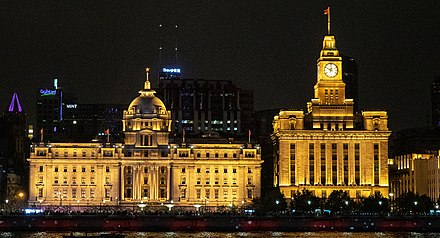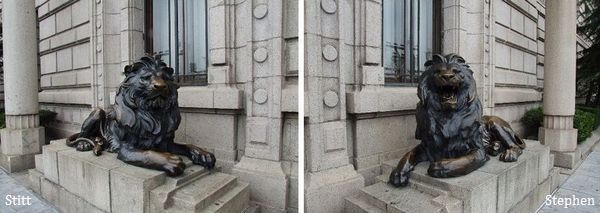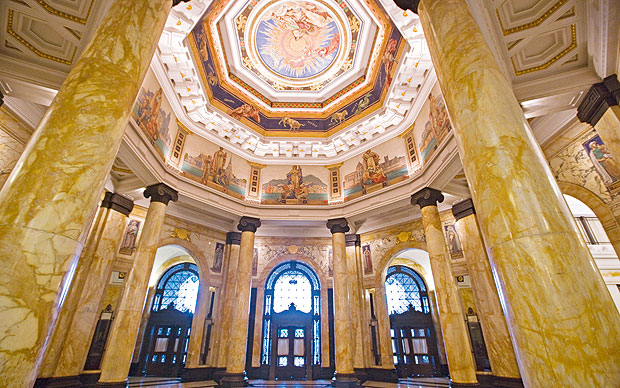 Since its construction in 1923 on the Bund, Building 12 has been occupied by different powers from its original owner the Hong Kong and Shanghai Bank Corporation to the current possessor the Shanghai Pudong Development Bank. Designed by the British architecture firm Palmer & Turner Architects and Surveyors, the HSBC Building is a bright pearl on the Bund. This article will explore the architecture’s site, scale, and ornamental compositions, which contribute to the banking power and commercial function of HSBC.
Since its construction in 1923 on the Bund, Building 12 has been occupied by different powers from its original owner the Hong Kong and Shanghai Bank Corporation to the current possessor the Shanghai Pudong Development Bank. Designed by the British architecture firm Palmer & Turner Architects and Surveyors, the HSBC Building is a bright pearl on the Bund. This article will explore the architecture’s site, scale, and ornamental compositions, which contribute to the banking power and commercial function of HSBC.
The HSBC Building located next to the Custom House in the center of the Bund, yet the building’s scale is not inferior (rather ….) compared to its neighbor. The strategic place allows HSBC to fully exploit its commercial function. Since the businessmen on the Bund would have to cooperate with the ICMCS office in the Custom House, there is an increased chance for them to walk pass by the HSBC Building after finishing the document in the Custom House. In this way, the likelihood to receive deposits is higher for the bank as it gains this prime location. Appreciating the two buildings from the Pudong side of the river, one will notice that the HSBC Building as a focal point is even more significant than the Custom House. This magnificent scale is established by the building’s elongated and horizontal layout compared to its neighbors’ narrow and vertical style. This horizontal layout indicates HSBC gained the advantage over other powers to not only have access to the water but also have the widest space coverage on the Bund. The supreme site and the remarkable size of the building both signify HSBC’s dominating power on the Bund in the early twentieth century.
The architecture’s exterior decoration and material further strengthen the opulence of HSBC, which contributes to the bank’s credibility among its customers. The HSBC Building takes the neoclassicist style but with six ionic columns as decoration in the center of the architecture. These ionic columns are imitation of Greek temples, symbolizing the Greek Revival style, which was the most popular architectural trend around the world at that time. By displaying this latest trend on its headquarters, HSBC demonstrates its progressive attitude and advanced power (how and why the greek revival style would reinforce the banking credibility). The material for this building is granite bricks, which is named as the “king of architecture material”, also used for the Monument to the People’s Heroes in Beijing. In this way, the architectural material granite itself speaks for the monumentality (yes, but why) of the HSBC Building.
 Taking a closer perspective of the HSBC Building, the delicate and luxurious ornaments highlight the firmly established status of the bank. A conspicuous decoration next to the gate of the building is the pair of bronze lions. These two lions take different postures as one appears to be fierce and roaring in comparison to the other’s calm and peaceful gesture. According to the traditional Chinese belief of applying Feng Shui into architectural design, these lions represent both security and protection for the bank (introduce the topical claim at the beginning of the paragraph). This implicit meaning reflects the HSBC’s function of protecting and securing customers’ wealth. The intricately designed dome features with frescos of the eight cities that HSBC had branches, including Tokyo, Hong Kong, London, etc. These frescos enhance HSBC’s credibility to its clients as its power spreads across the globe.
Taking a closer perspective of the HSBC Building, the delicate and luxurious ornaments highlight the firmly established status of the bank. A conspicuous decoration next to the gate of the building is the pair of bronze lions. These two lions take different postures as one appears to be fierce and roaring in comparison to the other’s calm and peaceful gesture. According to the traditional Chinese belief of applying Feng Shui into architectural design, these lions represent both security and protection for the bank (introduce the topical claim at the beginning of the paragraph). This implicit meaning reflects the HSBC’s function of protecting and securing customers’ wealth. The intricately designed dome features with frescos of the eight cities that HSBC had branches, including Tokyo, Hong Kong, London, etc. These frescos enhance HSBC’s credibility to its clients as its power spreads across the globe.
The HSBC Building earns its reputation as journalists once described it as “the most luxurious building between the Suez Canal and the Bering Strait.” The site, scale, and intricately designed ornaments on the HSBC Building persuasively articulate the power of HSBC and its commercial significance.
Citation: Xin, Xu. “A Gem in the History of Chinese Architecture: Bund 12.” Journal of Property Management Vol. 78, Issue 3 (May, 2013). https://go.gale.com/ps/i.dop=AONE&u=brun62796&id=GALE%7CA331486694&v=2.1&it=r&sid=summon


